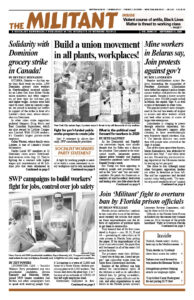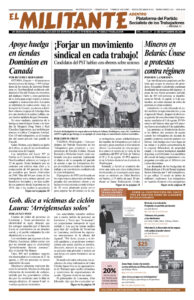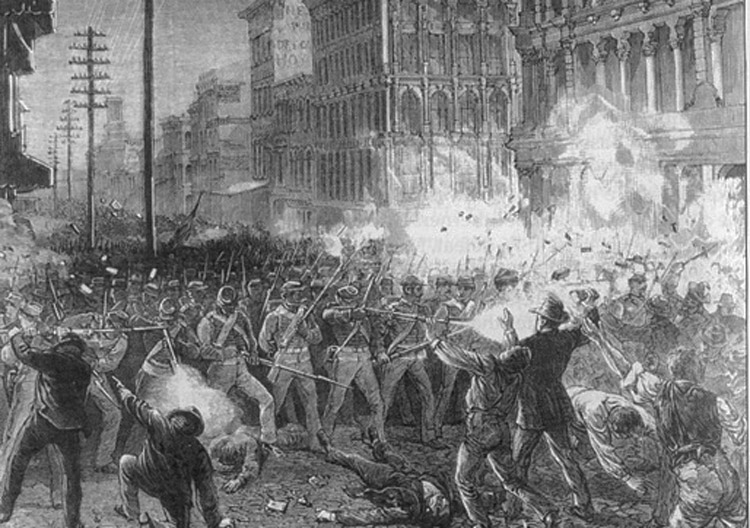One of Pathfinder’s Books of the Month for September is The Great Labor Uprising of 1877 by Philip S. Foner. After four years of economic depression, a walkout by West Virginia railroad workers developed into a nationwide strike involving 100,000 workers, the first truly general strike in U.S. history.
This excerpt quotes from a letter by Karl Marx to Frederick Engels, the founding leaders of the modern communist movement. It describes how the strike combined with the evolution of class forces in the U.S. shows the central forces of the coming American revolution, “the negroes … [and] the peasants of the West” are becoming “militant allies of the workers.” Copyright © 1977. Reprinted by permission of Pathfinder Press.
“The industrial disturbances of 1877, the first great manifestation of industrial and social unrest in this country,” wrote Thomas J. Morgan of the Chicago WPUS [Workingmen’s Party of the United States], “gave us the sympathetic ear of the discontented toiler.”
In the course of the strikes, as we have seen, party leaders addressed large audiences — sometimes as many as ten thousand — and were able to reach more American workers in two weeks than socialists in this country had in two-score years before. Moreover, the party speakers made it quite clear that they were speaking for a socialist movement. “I would have you understand that what I say tonight,” declared Albert R. Parsons to more than ten thousand workers at the Chicago meeting of July 24, “is not as an individual, but as a member of the Workingmen’s Party of the United States. (Loud applause.) What I say represents the principles, platform, and performances of the Workingmen’s Party of the United States.” For the first time, many workers heard discussions about the nature of the capitalist system and how socialism intended to solve many of these problems; how the government was controlled by the capitalists; and how the press served the interests of the corporations. The workers’ own experiences during the Great Strike lent credence to the analysis provided by the WPUS spokesmen. Small wonder, then, that the party enjoyed both an increase in enrollment and a growth in its press circulation. …
Despite the threat of swift retaliation in the form of dismissals and blacklisting in many industries, the months following the Great Strike witnessed meetings of workers where they laid plans to rebuild their unions, shattered by four years of paralyzing depression, and even to start new ones. Yet, because of the widespread reprisals, in many cases they had to meet and operate secretly. “The recent troubles,” a Pittsburgh paper reported in mid-August 1877, “have given a great impetus to the growth of secret labor organizations and workingmen by the hundreds are paying their necessary dues and taking strange oaths — but all in secrecy.” Such organizations, it noted, had names like Sovereigns of Industry, and Junior Sons of ’76, but the most prominent of them was called the Noble and Holy Order of the Knights of Labor.
Although it had played no role in the Great Strike, the Knights of Labor had benefited considerably in growth from the labor uprising. At its General Assembly in January 1878, the order established its first permanent national organization and began the drive to organize workers regardless of skill, sex, race, color, or nationality, which was to make it the dominant labor organization of the 1880s. That same year, the Marxists, who had left the WPUS, established the International Labor Union, together with eight-hour advocates Ira Steward and George E. McNeill, to organize the unskilled workers, especially those in the textile industry, unite them with the skilled workers, and together build a new American labor movement. At the same time, the Marxists played a significant role in the revival of the national trade unions, the organization of new national trade unions, and their federation for collective action. These efforts laid the foundation for the modern labor movement and produced, among other things, a federation of trade unions that has continued, although in a different form, up to the present day — the American Federation of Labor.
It is clear that although the strikers returned to work without wage increases, they did not return demoralized. At the end of the Great Strike, the British ambassador wrote to his government from Washington, D.C.: “The power wielded by the great corporations in this country is almost incredible and in their treatment of their subordinates they ignore entirely the principle that property has its duties as well as its privileges. Unless the lesson which they have now received should open the eyes of those corporations to the necessity of some radical improvement in the relations of capital to labour, I much fear that the only result of this strike will be to show the labouring classes their strength and to enable them still further to improve for future use the organization which it has now cost so much trouble and bloodshed to subdue.” As we have seen, this proved to be an accurate prediction. The Great Strike, which was described in the WPUS journal, Labor Standard, as “The Second American Revolution,” became the springboard for political and trade union action by the American working class. It was able to assume this character because it was more than a strike movement against wage cuts. It was a social rebellion, the first assertion by a national working class of a common anger against a variety of grievances — years of brutal exploitation, and a system of industrialization which viewed the worker as little more than part of the machine, who could be discarded the moment he was no longer needed, and which required him to adjust to a deadening routine of work that made him practically part of the machine. It was the first real evidence of working class collective power capable of imposing its own will upon future social developments. Workers from New York to San Francisco understood, for the first time, their potential power. …
Writing to Friedrich Engels, Karl Marx called the Great Strike “the first uprising against the oligarchy of capital which had developed since the Civil War,” and predicted that while it would be suppressed, it “could very well be the point of origin for the creation of a serious workers’ party in the United States.”


